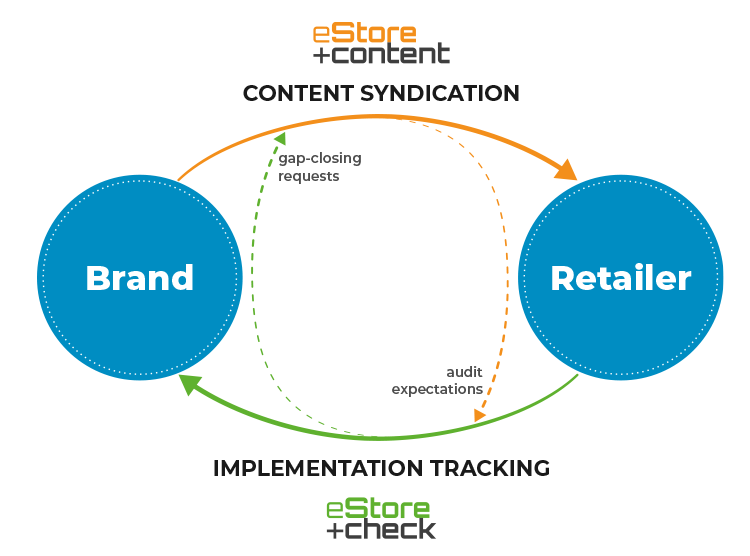In the e-commerce world, automation can go a long way to relieving pressure on already overburdened sales and brand teams.

E-Commerce is task-intensive. Organizing listings. Creating, and managing rich content and distributing it to numerous retailers in multiple markets, possibly involving different languages. Understanding competitive pricing and executing promotions. Engaging with consumer reviews and optimizing online-store search performance.
All these interdependent processes involve 100s of individual tasks as well as the coherent exchange of communications, data and assets between brand teams, agencies and e‑commerce sites. Trying to get it right can be overwhelming. Moreover, as soon as you do get it right, things change. E-retail is in a seemingly constant state of flux, which requires brands to regularly reinvent how they manage e-content design and delivery, sales and item promotion.
Automated Enterprise
It might seem next to impossible to keep up. Unless you follow the example of e‑commerce leaders such asAmazon,Ocado andeBay and automate as much as possible. Amazon for example, has made no secret of its desire to be as close as possible to a fully automated enterprise. By the end of 2017, it already had more than100,000 robots picking and packing orders in warehouses around the world. UK online grocery pure-play Ocado may have suffered a setback when it’s automated Andover warehousecaught fire in February this year, but it’s unlikely to hold the company back for long.
To maintain service to shoppers after the fire, Ocado opted to use part of its facility at Erith, in south-east London that was originallyearmarked for Morrisons. In the meantime, Andover is being rebuilt and Ocado has also announced plans to build a new warehouse in Purfleet, Essex.
Ocado and Amazon are extreme cases in the drive for e-commerce automation. We don’t expect brands to fully replace their sales and marketing teams with robots and algorithms anytime soon – or ever. However, there is still a lot you can do to automate many of the tasks involved in online channel merchandising, to reduce redundancy, facilitate information flow and free up scarce personnel for more productive activity.
Managing Complexity
Recent experience in e-commerce has shown there’s always something to be improved, whether it’s tweaking product listing or content, or optimizing search, i-media, promotions or price. Some of the challenges brands face on a daily basis include:
- Listings: must-stock items going out of stock, or lower than expected in-store presence.
- Content: missing images, inaccurate, ineffective, outdated product descriptions, missing product cards on key online sites.
- Search: poor search results for key category search terms versus competitive items.
- Rating & Reviews: not enough positive product reviews to impact sales growth.
- Price & Promotions: pricing is out of acceptable competitive ranges and promotions not delivering results against competitive products.
- iMedia: online trade marketing placement, vehicle or creative not getting enough clicks to drive conversion and justify spend.
Fixing these issues is not trivial, and the speed of change in the online channel makes it difficult for brands to keep up with all of the processes and tasks needed to ensure optimum performance. Research carried out by eStoreMedia shows that average implementation against goals for critical factors such as listings in-stock, content, price & promotions compliance, ratings & reviews and fair-share of search can be as low as 37%.
This means brands are a long way off achieving e-commerce perfect store compliance. The gap is understandable given the number of activities involved in listing a product in an online store, keeping it in stock and engaging consumers to meet sales targets.
Automation can go a long way to relieving pressure on already overburdened sales and brand teams. The underpinning of intelligent automation includes effective process design, data, and technology. With the right tools all of these factors can be tracked, providing data to identify gaps in your online channel representation. The digitization of retail offers brands and retailers an opportunity to take advantage of available data as never before – not only to deliver insights and alerts, but also to direct and automate many of the day-to-day gap closing processes needed to drive online sales growth.

eStoreMedia is at the forefront of e‑commerce automation for brands with its e‑Commerce Perfect Store Framework, and integrated solution set including:
· The e‑Commerce Perfect Store Framework for planning and organizing e-commerce strategies to deliver ongoing improvement and growth.
· eStoreCheck: Digital shelf monitoring to rapidly identify gaps in listings, content, price, ratings & review, search performance and iMedia execution.
· eStoreContent: The complete Product Information Management (PIM) and rich content syndication solution, for streamlining and integrating end-to-end content creation, management, and distribution.
The three pillars provide seamless integration from e-commerce strategy, to content management, performance measurement and gap-closing automation. Find out how eStoreMedia can help your organizationautomate for e-commerce channel success today.




